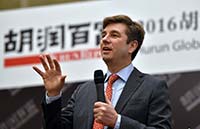

The release later this month of government proposals to reduce income inequality will provide early evidence of whether a change of leadership in China has given new momentum to economic reform. The plan has had a slow journey to this point: it has been eight years in the drafting.
That is not to say that the previous leadership did nothing to address income inequality. Many of the signature policies of the last few years were explicitly directed at improving the lives of China's poorest families. Agricultural taxes paid by farmers were eliminated. Rural residents were brought under the umbrella of a basic pension scheme and rudimentary health insurance was expanded to cover virtually all of China's population. At the same time, significant investment was focused on the poorest provinces to make up some of their deficits in infrastructure.
Nonetheless, most estimates show that inequality widened over the past decade and that the disparity between rich and poor today is the greatest it has been in the post-reform era. The richest 10 percent of households in China own 85 percent of its wealth, according to a recent survey, whereas more than the 75 percent of wealth is held by the richest tenth of households in the US. Despite the margin of error in such surveys, the wealth gap in China is really as alarming as in the US.
The significant improvements in the social safety net of the last few years failed to reduce inequality because they sought only to reduce the stress faced by the poorest households. They did not address the reasons why strong economic growth was failing to deliver strong increases in the income of poorer households in the first place. A large part of the problem, as the Development Research Center of the State Council noted in its "China 2030" report, published jointly with the World Bank earlier this year, is that wages have accounted for a shrinking share of national income.
An economic model that has prioritized capital-intensive industry and, in recent years, given many advantages to State-owned enterprises, has failed to generate as many jobs as other economies at a similar stage of development. Heavy industry has boomed. Large enterprises have prospered. But the service sector and smaller companies that tend to generate most new jobs have not kept pace.
The government, on its part, has paid for increases in its spending by raising taxes. The tax burden faced by China's workers is much higher than in most other emerging economies.
 Top 10 Chinese internet companies
Top 10 Chinese internet companies
 Fun time for children at international toy expo in Beijing
Fun time for children at international toy expo in Beijing
 Huawei launches new smartphone P9 in Vietnam
Huawei launches new smartphone P9 in Vietnam
 Top 10 box office movies on China market in H1
Top 10 box office movies on China market in H1
 Woman resigned from high salary job to make notebooks
Woman resigned from high salary job to make notebooks
 Hurun publishes Global Chinese Big Philanthropy Report 2016
Hurun publishes Global Chinese Big Philanthropy Report 2016
 Top 10 new economy issues in China
Top 10 new economy issues in China
 Wetland helps preserve ecology of Dianchi Lake
Wetland helps preserve ecology of Dianchi Lake

